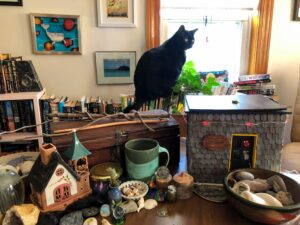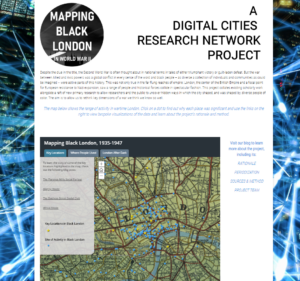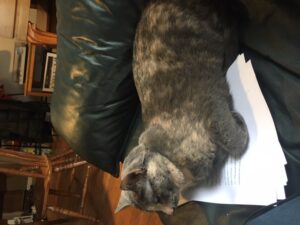Day of DH 2020 was organized by CenterNet as a way to encourage digital humanists “to communicate what they do on Twitter, what they are working on and the rhythm of their life in DH.” The Digital Scholarship Group and the NULab have collaborated on this post, bringing together some brief snapshots from the perspectives of our students, staff, and faculty. For more about the Day of DH, see the official site or follow the hashtag #dayofdh2020 on Twitter. We hope you enjoy reading about some of the people, activities, and work that comprise the DH community at Northeastern!
Julia Flanders, Director, Digital Scholarship Group
Day of DH, 2020: a sunny day in northwestern Rhode Island, with clouds gathering in the afternoon. A nearly full day of meetings, starting with some planning discussions related to our recent digital humanities faculty cluster hire, then the biweekly meeting of the DSG management team, followed by the library’s all-staff meeting and finally a meeting with partners at the Massachusetts Historical Society on their Mellon-funded Publication Cooperative. I also spent some time practicing my newly sharpened attention to my to-do list (now trying EverNote again for this, but streamlined), and thanks to the whole work-from-home thing I ate lunch with my partner instead of during a meeting.
One of the odd things about working from home (and doing Day of DH from home) is that the entire relevant world is concentrated inside the tiny compass of your computing device. You enter that space through whatever application you’re using (teleconferencing, authoring, designing, diagramming, data creation, whatever) and your mind goes whoosh, like a balloon being sucked into a bottle and taking the shape of that interior. In a virtual meeting, you inhabit a geospatially impossible universe where your co-participants are “located” within the tiny visible world of the application and within the slice of their physical reality that you can see in the background. Over time, seeing Patrick in his living room with the dark beams, and Third Floor Patrick in his studio with the dormer window, and Amanda at her standing desk against the Venetian blinds, and Rob at his desk near the stacks of boxes, I hold in my mind a strange world-simulacrum that can be navigated, imaginatively, just as I would project my thoughts to Rob in his office in LTS, or Third Floor Patrick “up” on the third floor, or Amanda through the wall of my office in the DSG. In the same way, meeting with the students in the DH certificate program this week to discuss their projects and development plans for the summer, I move about within a kind of ever-growing mental index (or perhaps something more like a graph database?) in which each student, and my knowledge of their skills and needs and hopes, and my awareness of their personhood, and the things I love about their projects, and the things I want to talk with them about, are all coordinated and interlinked like a vast model: something whose informationality and virtuality was formerly obscured by the vividness of physical presence. In my office at the Northeastern University Library, the inner and outer world of “my job” were tightly sutured together: when I looked up from my computer, there was the actuality of a colleague or student or an artifact of my work—books for DHQ to review, swag from other DH projects, my homeward train on its tracks. Now, when I look up, I see the apparatus of a different life that makes the space inside my head and my computer feel more jarringly constructed.
Did I just reinvent Romanticism? Or mysticism? Let me shift gears: for me, the compelling things about digital humanities have to do with the way it interweaves matter and information, in ways that range from Lauren Klein’s work on the history of visualization (as in her great 2015 talk at Northeastern, https://web.northeastern.edu/nulab/lauren-klein-feminist-data-visualization/) to Matthew Kirschenbaum’s exploration of concepts like “formal materiality” in Mechanisms [https://mitpress.mit.edu/books/mechanisms]. Working from home has also meant losing a three-hour commute each day—a restoration of non-work time that lets me remember there are things I care about besides my job. I’ve been spending a lot more time weaving, spinning, and knitting, all different aspects of the artisanal textile workflow that focus my attention on the formal and forensic properties of these systems, and the varied ways that these practices both love and exist in friction with their own formal and material properties. I’m also getting a different set of perspectives on things like documentation, consistency and validation, design processes, and notational systems—all of which I think about a lot in my digital humanities work as well.
Patrick Murray-John, Associate Director for Systems in the Digital Scholarship Group
Well, it’s a big day in Patrick-land. We have happy things going on with new major revisions to some of our primary systems: our digital repository (Digital Repository System), our publishing system based on WordPress (CERES), and a workflow-to-publishing (Charon) project management system (among other things). Much of that work is all about updating the APIs involved. As such, we’re examining the pain-points in the existing APIs, and reconciling them with the new features we’re working on across projects. That’s a good Day of DH!
Perhaps more mundane, but super important, every Wednesday involves a check-in with one of our developer groups to ask what, if anything, should be on our agenda for our semi-regular Thursday meeting. If I had my druthers, agendas would be set earlier, but in DH things seem to move quickly, so I’m happy to make a quick Slack convo the prelude to the next day’s meeting, including a consensus that a meeting isn’t needed.
In this time of WFH, I’m also trying to figure out a bunch of remote talking via new mediums (Skype, Slack, Zoom, MS Teams). So, a learning curve on all of those beyond just everyone piling in to a call — there is, rightly, figuring out security and access and organizing the needed people ahead of a call.
Sarah Connell, Assistant Director, Women Writers Project & NULab for Texts, Maps, and Networks
One of the biggest differences for me in working remotely is that I’ve found meetings to be much more challenging. I hadn’t realized what an impact it made to be able to change rooms or buildings between in-person meetings; six or seven hours of meetings a day are very different when they’re all in the same chair and the only change is in the call platform (for instance, I had 8 meetings this past Monday, on 5 different platforms). To alleviate that a bit, I’ve tried to make my home workspace as friendly as possible. I’ve upgraded to an actual office chair, from the wooden three-times-handed-down chair I’d been using, and I keep my space as tidy as possible. It also helps that I have a small accumulation of treasures set out on the other end of the elderly kitchen table where I work. Anyone who works with me is by now very familiar with the view from behind where I sit: the photo below shows what’s in front of me, including one of my favorite treasures, a tiny bookshop that my sister made me, cleverly called “Analogue Humanities” (and, of course, at least one cat, as is standard for WFH pictures these days). One of my new rituals in this remote world is that I’ve started switching the little lights in the bookshop on when I start work and then off at the end of the day—it’s a bid odd, perhaps, but it provides a light sense of companionship, which I’ve found to be helpful.
That said, today was actually a fairly light day for meetings, with only a few hours. I started by doing some budget wrangling for the NULab, getting ready for the end of the fiscal year. I also caught up on my email and took care of some small tasks, including setting up a new trial account for Women Writers Online and sending some resources to students in the DH Certificate Seminar class that I’m co-teaching with Julia Flanders. Then, I had a meeting with Olly Ayers and Gaby Fiorenza to plan a launch celebration for the Mapping Black History in World War II project. Olly, a Senior Lecturer in History at the New College of the Humanities (NCH) at Northeastern in London, is a new NULab faculty member who’s been working with Northeastern History PhD Candidate, Will Whitworth, on a project to map the roles that black individuals played, and the spaces that they occupied, in London during the second world war. I’ve been watching this project take shape over the past year and I’m so excited about the launch, which we’re hoping will be in May or early June.
After that meeting, it was time to dive into my major project for the day: preparing for graduate student work at the NULab and the Women Writers Project over the summer. We have six student who will be starting in new roles next week, so I wanted to be sure that I had all the training materials ready for them, as well as a very clear sense of the projects that we’ll complete over the summer. I need all of our scaffolding to be especially clear, since it’s looking like we’ll be doing all our work and training remotely. This is the kind of more sustained task that I often have trouble finding the time for between meetings, so I was particularly glad for the lighter schedule today. At 2pm, I had the library staff meeting and then after that it was time to pull this blog post together and get a bit more done with the summer planning.
Today went by really quickly, which I’ve absolutely found to be the case since I started working from home. But, overall, it was a pretty good one and now it’s almost time to turn the bookshop light off and call it a day!

Moya Bailey, Assistant Professor of Africana Studies and Women’s, Gender, and Sexuality Studies
My Day of DH 2020 included an hour long talk with a social media platform about diversity and inclusion on said platform. When they emailed, I raised my concern around the language of “inclusion,” countering that inclusion implies bringing people into an already existing center. I asked if folks really want to be included or allowed to exist on the platform without being disproportionately surveilled. It was exciting to hear that they had read our (Sarah J. Jackson and Brooke Foucault Welles) book on #HashtagActivism and were familiar with the work of the Center for Critical Race and Digital Studies who are also raising these questions about people’s data on social media.
I talked a bit about how I want to see social media platforms be more transparent about how and why they work with the police to turn over data about users. Given the news media I’ve seen, social media platforms seem to disproportionately help the police when the suspect is Black. How can folks feel included if their content is being used against them?
All in all, the call was encouraging because I think social media platforms are taking in that they have a role to play in changing the way marginalized groups experience their platforms. There are few things more rewarding than seeing your scholarship being called on to make real changes in the world. Grateful for this Day of DH 2020!
Olly Ayers, Senior Lecturer in Modern History, New College at the Humanities (NCH) at Northeastern, London.
As a historian I’m always interested in weighing continuity and change and in the last few weeks both have oddly seem to stand out in equal measure. On one hand, archives and college shutting so abruptly meant being torn away from the sources and people I love yet, at the same time, teaching, administration and research have all found a way to continue…
Today was a case in point: I settled at my desk in the loft (not attic, haha) to plan a remote teaching session, and then it was time to dial into a meeting with NCH colleagues and external assessors to validate our new history degrees. It’s taken a lot of work by everyone at NCH over several years to be finally able to run programmes fully under our own steam and today’s event was a culmination of that process. It involved poring over all aspects of what we do already and thinking about where we can improve and grow…
… which, from my perspective, will draw on the digital history project I’ve been working on since January, which is nearly ready to be shared with the world: Mapping Black London in World War II is a GIS project that seeks to reveal hidden ways in which London shaped, and was shaped by, diverse people of color at a pivotal moment in global history. It’s been a wonderful way of building some rich connections with incredibly supportive colleagues on the Boston side of the NU family…
…which leads me to the end of my day: a call with Sarah from NULab and Gaby from CSSH to think about a virtual launch event for Mapping Black London. One upside of these difficult circumstances is that it forces us to be more creative and ambitious about how to connect virtually and it was great to learn from Gaby and Sarah about how colleagues in Boston have already begun to address these challenges. Here’s hoping the event allows us to make new connections that can be strengthened in person before too long.

Molly Nebiolo, History PhD candidate
During the quarantine, I have been working on three projects: a name encoding project for Intertextual Networks (part of WWP) that I just completed, my part time job as an encoder for the Adams Papers at the Massachusetts Historical Society, and a 3D modelling exhibit for my dissertation. I juggle these, and any reading, writing, and researching for my own work.
My days are monotonous. I begin around 10am, work for a few hours, then take a break to run, walk, or practice yoga. I try to fit in another couple of hours before I “call it a day” around 4:30-5pm. All of my work as both a graduate student and DHer is done online, so I try to limit time in front of a screen by reading paperbacks and cooking during my free time. I may start puzzling, too. The quarantine has zapped my energy and focus, so I aim for 4-5 hours of decent work-time. It’s all the productivity I can muster these days.
Sometimes Niles the Cat (pictured) likes to sit on my encoding papers so I have to wrap up my afternoons earlier than expected!

Anjelica Oswald, MA public history student and outreach coordinator for the Women Writers Project
I find that most days in quarantine are a mixed-bag of productivity and emotional turmoil. I tend to be more productive in the late afternoon, so making a work schedule for the day helps me stay on task. My mornings start with coffee and emails before I dive into a couple hours of work. I make lunch promptly at noon and watch something as I eat. After lunch I try to squeeze in around three to four more hours of work broken up between my paid jobs and research for my DH project. I’ll take pauses for a short workout or read for fun to relax my brain.
Though I am able to do most of my work and research from home, the quarantine makes everything just a little bit harder. My planned DH project relies heavily on archival research, and I’ve been running into some issues when online access fails. Archivists are also working from home so they don’t have access to the physical objects and items that could help move me along. But this lack of access isn’t keeping me or my project from moving forward. I’ve got books to read and digital programs to learn how to use. Recognizing that I don’t have to stop learning just because I can’t get access to everything now has been one of the main lessons I’ve learned during this pandemic.
I will also add that this quarantine takes any normally minor inconvenience and makes it a stressful experience. Last week my MacBook keyboard decided to quit working (again), and I had to take it to a computer store and get it fixed (the second time since January). I will hopefully pick it up later this week, but I now must do all of my research, writing, and meetings on a phone. It’s been frustrating and annoying, and I cannot wait until I have my laptop back. I also cannot wait for the world to return to some sense of normalcy, but until then, life is all digital all the time.
